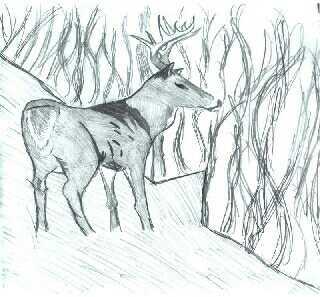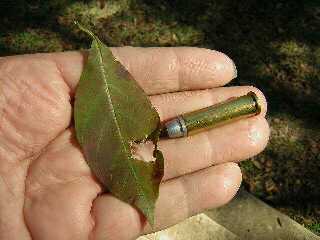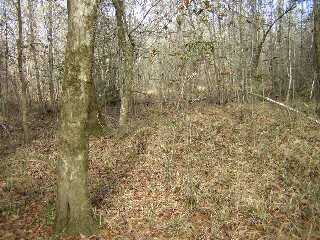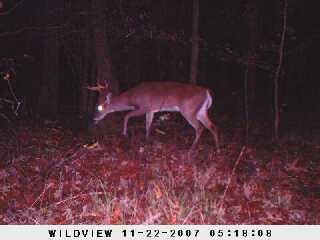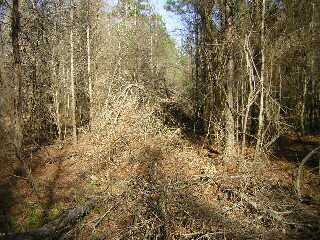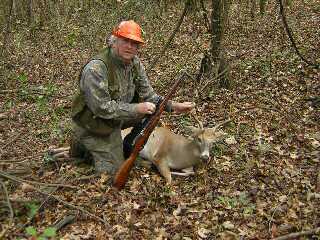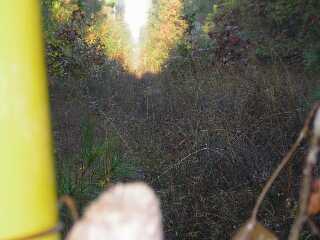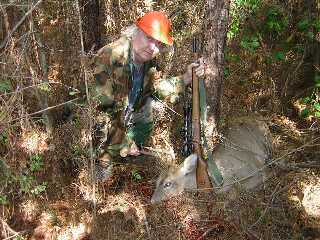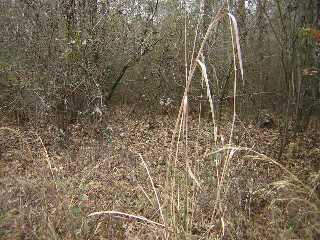Copyright 2008 by Junior Doughty
Click thumbnails for full size photos
|
My discovery of buck gates began while deer hunting on an icy morning in November 2005. I was easing down an abandoned oilfield road in the river bottom near my home. The sun had just poked over the trees directly behind me. My rifle that morning was my favorite rifle—a Rossi Model 92 in 357 magnum. I carried it hung at my side from a saddle ring sling, the butt tucked beneath my right elbow. The saddle ring carry allowed me to stalk down the road with the rifle ready but with my hands inside my pants pockets and wrapped around chemical warmer packs. I was shivering from the cold, having dressed too lightly. The sun rose a little higher behind me, and just ahead and to the right it illuminated an elongated, couch-sized patch of grass and weeds. I eased into the bright spot and stood there soaking up warmth on my back. Ahhh, it felt good. . . . Fifty yards ahead of me the road made a slight left turn. As I continued soaking up warmth, damned if a bush in the weeds at the turn didn't look a lot like a deer. Then the bush took a step and became a doe. I could have legally shot her, but I had venison in my freezer and the rut was on—there could have been a buck behind her. So I watched her step into the road, then cross it and casually walk into the bushes on the other side. I stood there not moving a muscle, except for shivering, and I kept on soaking up warmth while watching the bushes behind her for a buck. Suddenly, someone or something stuck what looked like a rocking chair out of the bushes and into the edge of the road. Dumbfounded, I watched the rocking chair step into the road and become an enormous whitetail buck, a buck with antlers like I had only seen in magazine photos. As my hands came out of my pockets and began to raise the Rossi, the buck stepped into the road, his eyes looking straight ahead to where the doe had disappeared. And now the rifle was raised, and I prepared to shoot. But something was wrong with the sights—I could see the front sight, barely, but the rear peep sight had disappeared, like I had no rear sight at all. For a panic stricken few seconds which seemed like minutes, I frantically tried to find the sights. And now the buck was in the center of the road and still walking. I pointed the Rossi like a shotgun and fired.
The aircooled wheelweight alloy RCBS 38-158-SWC bullet @ 1800 fps with Lil'Gun killed this leaf dead, dead, dead. . . . Forensics soon discovered my sight problem. The rising sun had beamed directly over my right shoulder and straight into and onto the rear peep sight, obliterating it. Remember that fact the next time you decide to warm yourself in a spot of sunlight. At that point, the monster buck became "Ol' Mossy Horns," and I became determined to redeem myself and kill him.
I discover a buck gateNear the end of season 2006 - 2007 I had killed 2 bucks, neither of them even close to Ol' Mossy Horns's size. Here in Louisiana we're allowed 3 bucks and 3 does per season. After I killed my second buck, I started hunting does only, keeping the #3 position open for Ol' Mossy Horns. One morning in the deep woods I was sitting on the ground and leaned back against a tree. A deadfall in front of me partially hid me, and I had positioned some of the limbs at both sides of me as even more cover. I had a comfortable stand and a good location for a possible shot at Ol' Mossy Horns. The missed shot a year before had happened some 300 yards behind me, so I was in his neighborhood. Ahead of me like a living wall a dense thicket stretched 200 yards or more through the deep woods. To my right along the edge of the thicket, I had maybe a 75 yard shot through scattered large oaks. To my left, the same thicket stretched maybe 100 yards along an old haul road overgrown with weeds. So I had 150+ yards of the deep woods covered. My rifle that morning was my "Woods Rifle," a Model 94 Winchester 30-30 loaded with aircooled wheelweight alloy RCBS 30-180-FN bullets @ 1900 fps with Varget. I sensed movement to my left and turned my head. A very nice 6 or even 8 point buck was strolling down the haul road toward me. As I pondered the #3 position held in reserve, the buck continued strolling toward me and soon reached me, passing within 25 yards of me. It seemed to be headed somewhere specific, walking fast along the edge of the thicket and looking straight ahead. I raised the rifle and put the front Fire Sight on the side of the buck's chest and pondered even harder the #3 position held in reserve. But the memory of Ol' Mossy Horns came, and I lowered the rifle and watched the buck walk away—with a rack almost anyone would hang on their wall. About 50 yards past me, he made a sharp left turn and disappeared inside the thicket. His previous demeanor had made me wonder if he had somewhere specific in mind, but the curious sharp left turn convinced me that he did. I got up and walked over to the spot where he made the left turn.
In the background you see the thicket from left to right across the picture. In the near foreground, slightly left of center, see an oak tree. Follow its dim shadow to a buck gate through the thicket. In the full-size photo you'll see other places where a slick-headed doe could weave her way through the thicket, but this buck gate is the only place along 200 yards of thicket where an antlered buck could simply lower his head and walk on through to the other side. Season 2006 - 2007 ended leaving Ol' Mossy Horns chasing does and dodging bullets—as I will explain later in this article
Over a week's time, the trail camera caught 5 different bucks going in or coming out of this buck gate. Their antlers ranged in size from a spike to a 10 point. After that week, the camera caught nothing but daytime crows. In other words, all the deer in the river bottom alerted to the camera flash and avoided coming near this buck gate. Remember that fact if you sit in the same stand day after day and wonder why you don't see deer.
More buck gates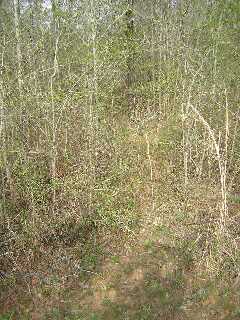
This one is down an old logging road in the river bottom. Notice the pencil thin and tan weed slightly right of the photo's center. I positioned the camera so the weed aligned with the deer trail through the thicket beside the road. Up and down this section of the road there's places where does weave through the thicket, but this is the only place along 100+ yards of road where an antlered buck can easily pass through the thicket. There's a couple of small branches in his way, but he could simply brush them aside. There's not a single sawbriar vine in this gate to snag an antler tine.
A logging skider created this buck and doe gate, not Mother Nature. Instead of a thicket, here we have a brush fence created by a skider pushing over trees and brush along a property line. This brush fence is 1/2 mile long and marks the boundary between the property of two landowners. In this case it also marks the ecotone, the zone between two different ecosystems. To the left, there's hardwood river bottom land. To the right, there's upland pine plantation land. The upland pines have been rowed to thwart southern pine beetles, i.e., arrow-straight clearings have been cut 30 yards or so apart through the trees and extend sometimes for a mile. That allows sunlight to reach otherwise shaded forest floor. Grass grows in the long clearings and brush also grows there and along the edges. In my considerable experience, an ecotone is an idea place to deer hunt due to deer traveling back and forth between the different foods in different ecosystems. Deer in the area shown above eat acorns on the land to the left and grass and leaves on the land to the right. Deer can't walk through this brush fence, and they can't jump over it. Both bucks and does must walk through this opening, this gate. It's the only opening in maybe 1/4 mile of brush fence. The brush fence buck gate shown above gave me this smallish 6 point buck during the 2007 - 2008 season in November 2007. The rifle is an M38 Mosin-Nagant with a scout scope. It's loaded with a 196 gr .318" jacketed bullet home-swaged to .3155" and pushed to a mild 2100 fps with surplus 4895 powder. The buck ran maybe 25 yards. This buck was the second one I saw that morning headed to the buck gate shown above. The optics on the cheap scope you see here cost me a shot at the first one. Here's an early morning view from what my nephew and I call "the dogleg stand." It's a ground stand beside a yellow mile marker on a dogleg turn of an abandoned pipeline. I made a rifle rest via wiring a chunk of wood to the side of the yellow plastic pole. I tied leafy limbs across the front of the pole as camouflage. See the brown bush in shadow some twenty yards out to the right? Remember it, please. During the 2006 - 2007 season I was sitting on a bucket behind this pole. That day I carried my 8x57 Turk Mauser pipeline rifle loaded with 185 gr Remington PSPCL bullets pushed with surplus 4895 powder to 2395 fps. As usual, I was after Ol' Mossy Horns although buck positions #2 and #3 were open. I took a swallow of water from my canteen, then placed the canteen on the ground beside my bucket stool. When I raised my head, there walked a buck near the edge of the sunlight you see in this photo, about 100 yards away. He was walking straight toward me up a four-wheeler path down the center of the pipeline. I carefully raised the Mauser to a rest on the wooden chunk and centered the crosshairs on the buck's chest. On he came. If I shot him head-on, I assumed, the high velocity bullet would penetrate his chest cavity and explode in his abdominal cavity, making a terrible mess come cleaning time. So I waited until he decided to exit the pipeline and turned sideways, giving me a chance to put a bullet into one side of his chest and out the other side. But he didn't seem to want to exit and die neatly. On he came, making me wonder if he was going to walk to point blank range. Then, a yard or two on the other side of the brown bush, he turned to his left, and I squeezed the trigger. He bounded off the pipeline, and I soon heard him thrashing in the bushes. The distance of the shot was 25 steps. He was a ~200 lb 6 point. This was in November 2006. Looks like November is my lucky month. This buck probably outweighed the November 2007 buck by 50 lbs. Ol' Mossy Horns outweighs this buck by 25 to 50 lbs, and his rack is 3x to 4x the size of this one. Take another look at the pipeline photo I posted again. Notice the bright sunlight in both edges of the pipeline. It explains why thickets line roads and pipelines through deep woods. It's the only place a plant in the understory can get plenty of sun. Notice the far background where the pipeline crosses a small hill. It's a lasered 300 yards to the top of that hill. At about the 225 yard marker and to the left, there's another buck gate.
A few weeks after I killed the large 6 point related above, my cousin Mike Doughty was hunting the dogleg stand and using a Remington Model 7 bolt action in 30-06. Ol' Mossy Horns came out of this tunnel/gate and stopped in the middle of the pipeline and looked directly at my shocked cousin. Cousin Mike fired. Ol' Mossy Horns—untouched again!—took a couple of casual steps and disappeared. Later, when Cousin Mike related his tale of woe, he said, "Junior, I've never seen horns that big on a live animal." Here's the moral to this tale of buck gates: an animal with horns that big can't walk through a thicket in any ol' place. He has to find a gate.
|
